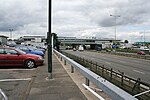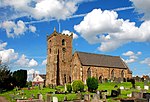Leicester Ivanhoe Cricket Club Ground
Leicester Ivanhoe Cricket Club Ground is a cricket ground in Kirby Muxloe, Leicestershire. The first recorded match on the ground was in 1952, when the Leicestershire Second XI played the Nottinghamshire Second XI. In addition, the ground has also held 2 Second XI Championship matches.The ground held its first Women's One Day International in the 1973 Women's Cricket World Cup between International XI women and Jamaica women. The next held 2 Women's ODI's in the 1990 Women's European Championship when Denmark women played Ireland women and finally with England women playing Ireland women, in what is to date the final Women's ODI held at the ground.In local domestic cricket, the ground is the home venue of Leicester Ivanhoe Cricket Club. who play in the Leicestershire Premier Cricket League.
Excerpt from the Wikipedia article Leicester Ivanhoe Cricket Club Ground (License: CC BY-SA 3.0, Authors).Leicester Ivanhoe Cricket Club Ground
Hinckley Road,
Geographical coordinates (GPS) Address Nearby Places Show on map
Geographical coordinates (GPS)
| Latitude | Longitude |
|---|---|
| N 52.61897 ° | E -1.23441 ° |
Address
Hinckley Road
LE3 3LU , Leicester Forest East
England, United Kingdom
Open on Google Maps








